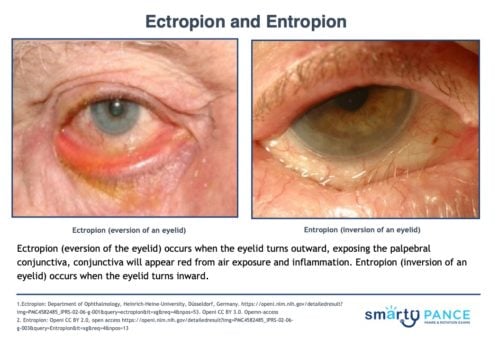Patient will present as → a 75-year-old with a foreign body sensation and tearing of his right eye. On physical exam, you note a red, irritated right eye in association with an inverted eyelid.
To watch this and all of Joe Gilboy PA-C's video lessons, you must be a member. Members can log in here or join now.
Entropion (inversion of an eyelid) is caused by age-related tissue relaxation, postinfectious or posttraumatic changes, or blepharospasm
- Eyelid turned in
- Eyelashes rub against the eyeball and may lead to corneal ulceration and scarring
- Symptoms can include foreign body sensation, tearing, and red eye
Diagnosis is clinical (eyelids turn in)
TX: tear supplements and ocular lubricants at night
- Definitive treatment is surgery
Question 1 |
A 71-year-old male presents to your clinic complaining of persistent irritation in his left eye, describing it as feeling like there's "a grain of sand" inside. He also reports excessive tearing. On examination, you observe that the left eyelid is turned inward, and there is noticeable redness of the conjunctiva. Additionally, you detect a corneal ulcer. What is the most appropriate immediate course of action?
Immediate referral to ophthalmology for surgical correction | |
Prescribe artificial tears and schedule a follow-up in 3 months Hint: While artificial tears can provide temporary symptomatic relief, they do not address the underlying cause of the corneal ulceration. Delaying definitive treatment can lead to further complications. | |
Prescribe a short course of corticosteroid eye drops Hint: Corticosteroids are not the first-line treatment for entropion and can potentially worsen the corneal ulceration. | |
Instruct the patient to use Tobramycin eye drops for 5 days Hint: While Tobramycin can treat bacterial infections, it does not address the mechanical irritation caused by entropion. | |
Apply a protective eye patch and reassess in one week Hint: An eye patch may protect the cornea temporarily, but it does not correct the inward turning of the eyelid. Delaying surgical correction can lead to further corneal damage. |
Question 1 Explanation:
The patient's symptoms and clinical findings are indicative of entropion, a condition where the eyelid turns inward. This can lead to corneal irritation and, as noted in this case, ulceration due to the constant rubbing of eyelashes and skin against the cornea. Immediate referral to ophthalmology is warranted for surgical correction, as this condition can lead to serious complications like corneal damage if not promptly treated.
Question 2 |
Which of the following is NOT a recognized risk factor for the development of entropion?
Advanced age Hint: Aging is a significant risk factor for entropion due to the relaxation of eyelid tissues and weakening of the muscles around the eyes. | |
Chronic blepharitis Hint: Inflammation of the eyelid margins, as seen in chronic blepharitis, can lead to scarring and changes in eyelid tension, contributing to entropion. | |
Facial nerve palsy Hint: This condition can lead to muscle weakness around the eye, potentially resulting in eyelid malpositions such as entropion. | |
Excessive use of contact lenses | |
Scarring from ocular trauma Hint: Scarring can disrupt the normal anatomy and tension of the eyelid, leading to entropion. |
Question 2 Explanation:
Excessive use of contact lenses is not typically associated with the development of entropion. Entropion, the inward turning of the eyelid, is more commonly related to factors that affect eyelid tension and structure, such as aging, inflammation, or scarring.
There are 2 questions to complete.
|
List |
References: Merck Manual · UpToDate


 Lecture
Lecture
